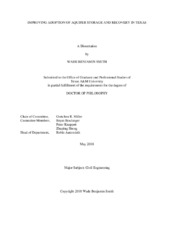| dc.description.abstract | Only three aquifer storage and recovery systems (ASR) currently operate in Texas, and less than 2% of Texas’ future water supplies are expected to come from ASR. Texas water utilities have avoided implementing ASR due to concerns with quality degradation, downgradient movement, and capture by nearby users that minimize recovery efficiency of injected water. This dissertation aims to identify locations for new ASR systems and offer suggestions for operational strategies that can minimize losses of injected water to these processes.
The first study identifies hydrogeologically feasible locations for ASR across the Gulf Coast and Carrizo-Wilcox aquifer systems in Texas, using transmissivity, hydraulic gradient, well density, depth to aquifer, and depth to groundwater using a GIS-based index. Corpus Christi, Victoria, San Antonio, Bryan, and College Station are identified as possible cities where ASR would be a useful water storage strategy.
In the second study, groundwater flow and solute transport models were developed to simulate movement and estimate recovery efficiency of injected water in a large scale (2.27x105 m3/d), multi-well ASR system near San Antonio, Texas. Recovered fraction estimates ranged from 54-90% for the first 9.5 years of actual operations and from 48-84% over a 19 year hypothetical operations scenario depending on longitudinal dispersivity. The results suggest that the same well in which water was injected should also be used for recovery to maximize recovery efficiency, but hydraulic effects between the wells must be accounted for, as they can adversely shift injected plumes away from ideal recovery zones.
The final study altered a previously-developed regional groundwater flow model to simulate and estimate the regional effects of the same ASR system in San Antonio. Such ASR systems may have large hydraulic effects on the nearby aquifer (<=2 miles) over short time scales. Over long time scales (decades), such ASR systems can raise aquifer heads as much as 3 feet 10 miles away. Pumping operations at this ASR facility correlate with both precipitation and other regional aquifer pumping, but precipitation is found to not be the sole predictor of ASR pumping operations. Transport simulations indicate that injected waters do not migrate significantly offsite. | en |


